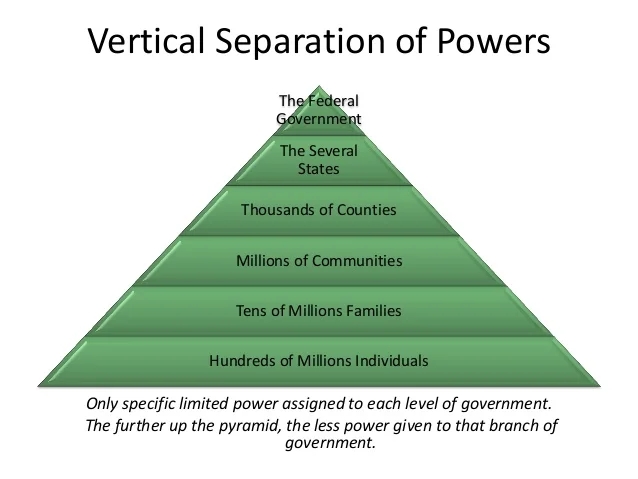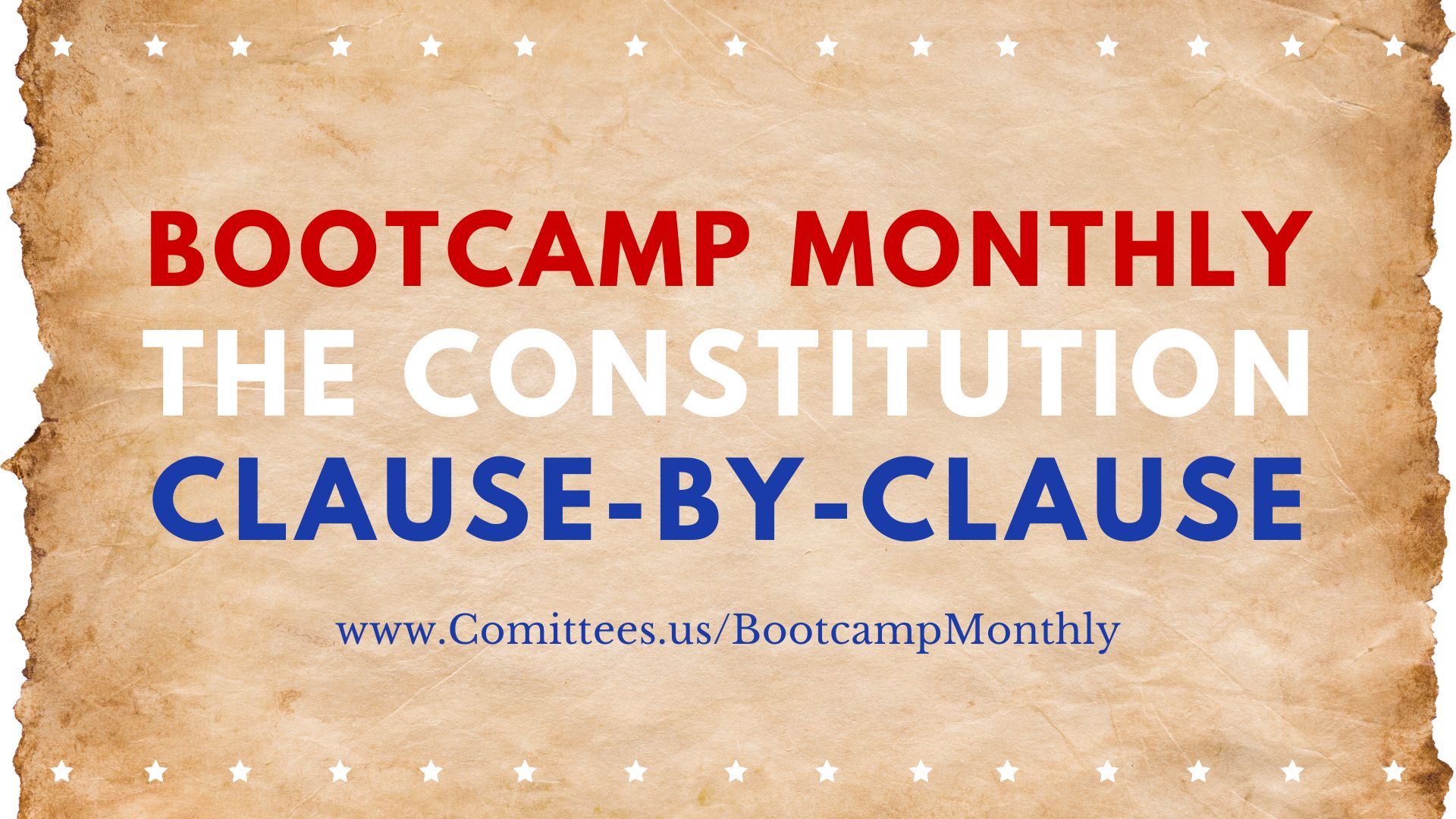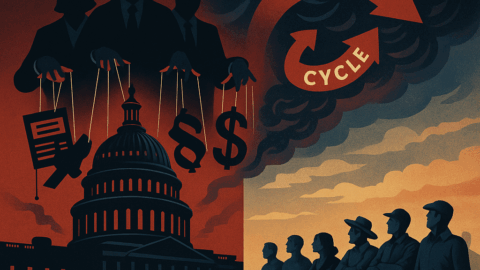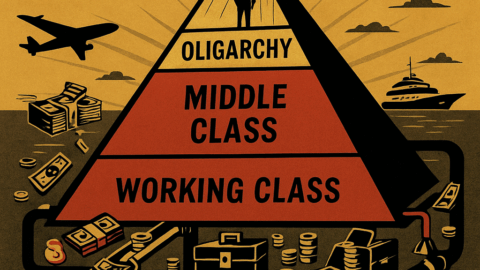“A people must from time to time, refresh themselves at the well-spring of their origin, lest they perish.” (1)
In studying American history, one will find an argument of who has the greater power, the Federal government or the individual states. Unfortunately, this discussion has been lost in time, but it is as crucial today as it was prior and post Declaration of Independence. It is as if it has been erased from our national minds, whitewashed and replaced with the ideology that the national government rules the day. We have national amnesia and it is time to rediscover this discussion and trace it back through the annuals of time by studying history to get clarity on this issue.
“It is difficult to escape the feeling that most of the young men and women who passed through our colleges in the years from 1933 to the present time (1955) do not have the faintest conception of the type of government which Americans for a century and a half knew as the American Republic.” (2)
As we can see, this investigation and statement was conducted in 1955. How bad do you think it is in 2023 that our colleges and schooling system fails and omits the “type of government” Americans are currently under.
This discussion needs to be resurrected again in order to understand the proper jurisdiction and role of government. We find the depth of engagement, knowledge and education into civil duties by way government and society; these spheres of understanding and caring shrinks with time as less and less personal and educational energy put into comprehending history, philosophy, psychology, economics and government.
As time goes by, history is lost to the current generations for many reasons. I would conclude it is because of lack of interest, knowledge, desire and distractions.
“. . . my people are gone into captivity, because they have no knowledge.” (3)
Our school system doesn’t teach our founding history anymore (Loyalists vs Revolutionaries Part 1, Part 2 and Part 3), through omission each generation is failing to understand what is the key ingredients to our individual and national freedoms and liberties.
It is our hope by looking back in time, a new found interest to investigation the matters even further will take hold and a tsunami of men and women will join the ranks of reinserting our God given rights once more by demanding the Original Intent of our Founding Fathers.
But first, we need to understand there were two main intents of the Founders. Once you see it, you can’t and won’t want to un-see them. By uncovering what has happened and the road we have traveled, we will be able to see the predicament we are now in as tyranny continues to travel down the wrong path to national and individual bondage.
Even in the circles of liberty minded people I am involved with, I am constantly hearing there are three branches of government. I believe this is dangerous, as it alludes to a powerful national government. That is not what the Founding Fathers created and contracted with We the People through the 13 Original States.
In referring to the United States Constitution:
- Article I deals with the Legislative Branch, which has the House of Representatives and the Senate.
- Article II deals with the Executive Branch, which is the elected president.
- Article III deals with the Judicial, the US Supreme Court.
We tend to forget Article VI, which is States’ Relations. It was about State Sovereignty and was retained by the Original 13 and was meant to continue in line of succession with every state joining the Union and confederacy.
In essence, what was created was called the “dual relationship”.
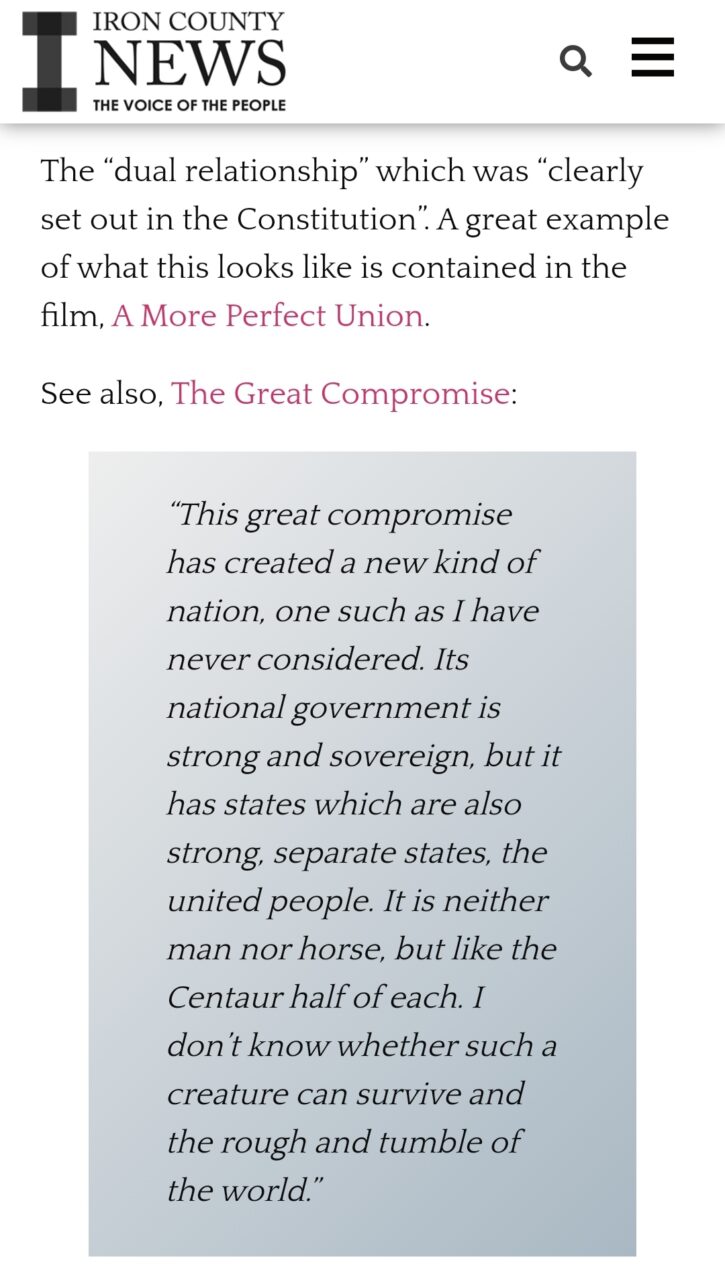
(4)
The US Constitution created a hybrid, a “Centaur half of each” with two forms of government: The Federal government and the State governments. It was a subdivision of all powers. It was in the form a vertical and horizontal.
“No, my friend, the way to have good and safe government is not to trust it all to one, but to divide it among the many, distributing to every one exactly the function he is competent to.”
“Let the National Government be entrusted with the defence of the nation and and its foreign and federal relations, the State government with the civil rights, laws, police and administration of what concerns the State generally, the counties with the local concerns of the counties, and each ward direct the interests within itself.”
“It is by dividing and subdividing these republics from the great national one down through all its subordinations, until it ends in the administration of every man’s farm by himself; by placing under every one what his own eye may superintend, that all will be done for the best.” (5)
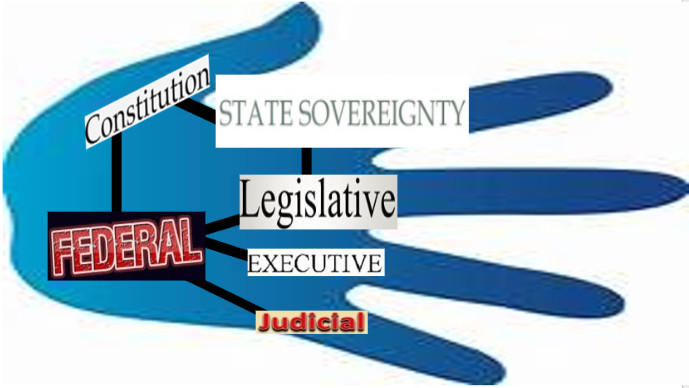
The Federal government was subdivided into three sections that the Original 13 States had delegated not ceded 30 to 35 in a comprehensive list that capped, limited and set boundaries on certain amount of powers to be retained on good behavior which are sustained by good government and can be found in Article I, Section 8 of the U.S. Constitution.(6)
There were no implied powers to be granted either as we shall see Hamilton hinted at while he was serving in George Washington’s administration.
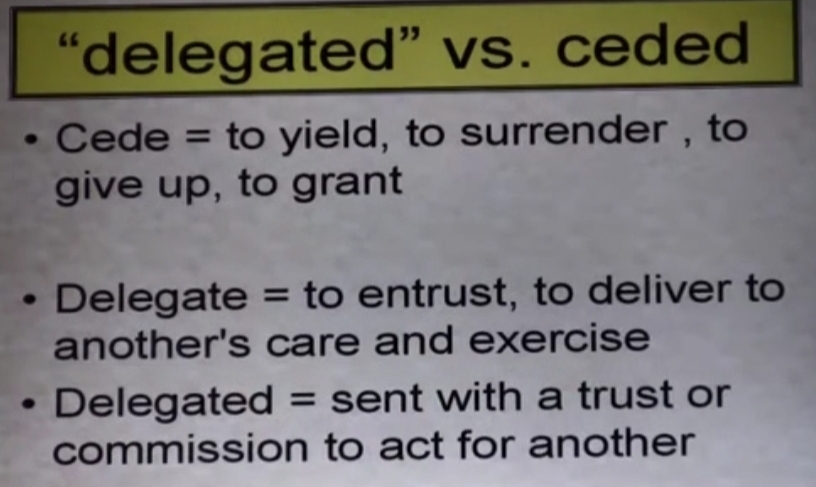
We need to understand how the Constitution was constructed in order to comprehend and appreciate the pains, energy and sacrifice of the direction and protection the US Constitution afforded Americans.
The delegated 30 to 35 cords were to bind the creature (Federal government) created by the creators (13 Original States) by way of a contract. These cords would be an allegory and used as a visual to what Gulliver’s travels.

“… in questions of power then, let no more be heard of confidence in man, but bind him down from mischief by the chains of the constitution ….” (7)
Thomas Jefferson was mentioning how the constitution was to be used as a tool to stop the passions and illegal conduct of activist judges and elected officials to being able to move away from the American government and how it was set up without insuring the States and We the People get involved in the process and discussion.
“On every question of construction (of the Constitution) let us carry ourselves back to the time when the Constitution was adopted, recollect the spirit of the debates, and instead of trying what meaning may be squeezed out of the text, or invented against it, conform to the probable one in which it was passed.”(7)
In essence, we must figuratively travel back in time by studying history and read and use the definitions and interpretations that were part of the “spirit of the debates” before and after. This is where the rubber meets the road.
Steve Jobs describes this point:
“You can’t connect the dots looking forward; you can only connect them looking backwards.”
And backwards into history is where we travel to unwind, comprehend and uncover the discussion taking place that is pertinent today as in the late 1700’s.
There were two major camps, even within the Founding generation. These two ideology’s emerged in the from of two mouthpieces that were leading opponents and proponents of ideology that were competing to direct our country.
The gap was probably very minimal in their time, but the gulf has widened as time has evolved and can really be noticed in our present moment in the time continuum if one takes the time to notice.
One was a nationalist, who wanted the Federal government to control everything, in essence wanted the United States to mirror the government of Great Britain, but have its own national government. This Founding Father was Alexander Hamilton. He wanted the States to return to the status of a province to the national government. In essence, an Administrative District subordinate to the national government.
“In a speech before the New York State Assembly . . . (Hamilton) argued that the “nation,” and not the states, had “full power of sovereignty” dating back even before the Articles of Confederation.” (9)
We can trace this philosophy through men and women into the past, even down to Abraham Lincoln and Alexander Hamilton. This philosophy is prevalent in our present day as well.
Nationalism and patriotism seems to have merged and used simultaneously to mean the same thing, but in reality both words have two different meanings, direction and outcome for our country when you trace the words and meanings to etymology.
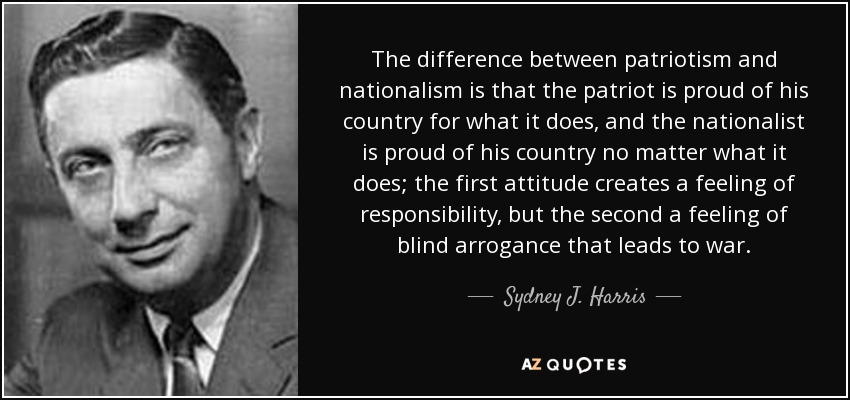
The other side of the opposition to Alexander Hamilton and his minions would be considered in today’s environment as radicals. The pendulum and ideology leading up to the Revolutionary War, the Founding Fathers generation would have been considered radicals. Once they won the war and started to fill the seats of government with people of the new American philosophy, for simplicity, they would have became the Loyalists.(13)
Today’s Revolutionaries view would be considered radical as they attempt to move the Overton Window. The loyalists have become complacent, comfortable and ignorant of our past and of the hidden class warfare (Part 1 and Part 2) taking place in our culture. (14)
There were contemporaries that fell in line with Hamilton’s line of thinking. Hamilton would have been the one of the most extreme nationalist in the Founding Fathers generation.
Who were the radicals of their Founding generation?
“The radical of one century is the conservative of the next. The radical invents the views. When he has worn them out, the conservative adopt.” (10)
A radical is one who throws out ideas and views for the public to mull over concept and to get people to do some critically thinking. These ideas have a tendency to push people out of their comfort zones.
“The American Revolution, like all great social upheavals, was brought off by a disparate coalition of competing view-points and conflicting interests. At one end of the Revolutionary coalition stood the American radicals – men such as Samuel Adams, Patrick Henry, Thomas Paine, Richard Henry Lee and Thomas Jefferson. Although by no means in agreement on everything, the radicals objected to excessive government power in general and not simply to British rule in particular. They viewed American independence as a means of securing and broadening domestic liberty. Spearheading the Revolution’s opening stages, the radicals were responsible for all the truly revolutionary alterations in the internal status quo: the abolition of slavery in the northern states, the separation of church and State in the southern states, the rooting out of remaining feudal privileges everywhere and the adoption of new, republican state constitutions containing written bills of rights that severely hemmed in government power.” (11)
Mark Twain’s concept can be used in reverse as well. A radical can be a Leftists or Revolutionary who “invents the views,” plants the seeds and in one century a society can evolve into a planned socialist or communist society.
A perfect example and illustration of this concept in action would be the Overton Window.
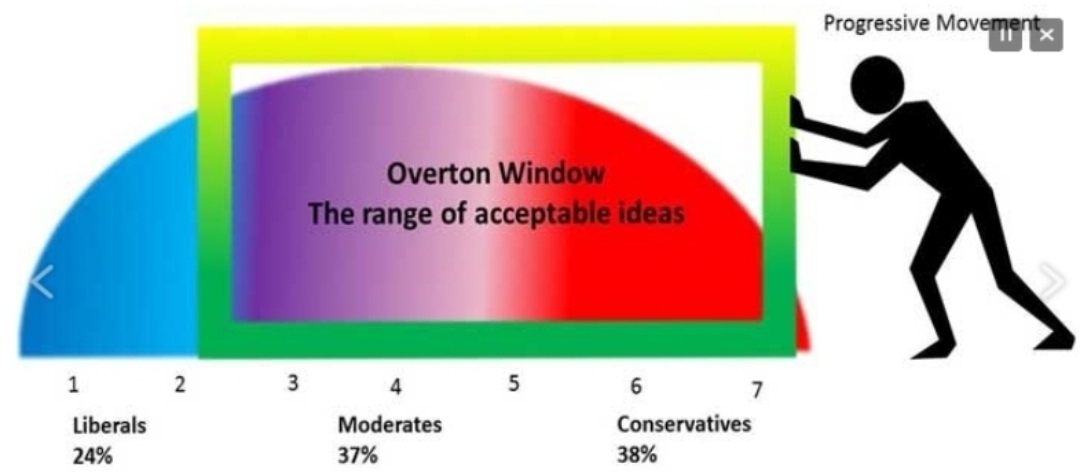
We need to understand what is American and un-American in order to compare the values to comprehend the direction the Overton Window is pushing our society in the present moment and has been doing so gradually over time. It could also be called creeping normality.
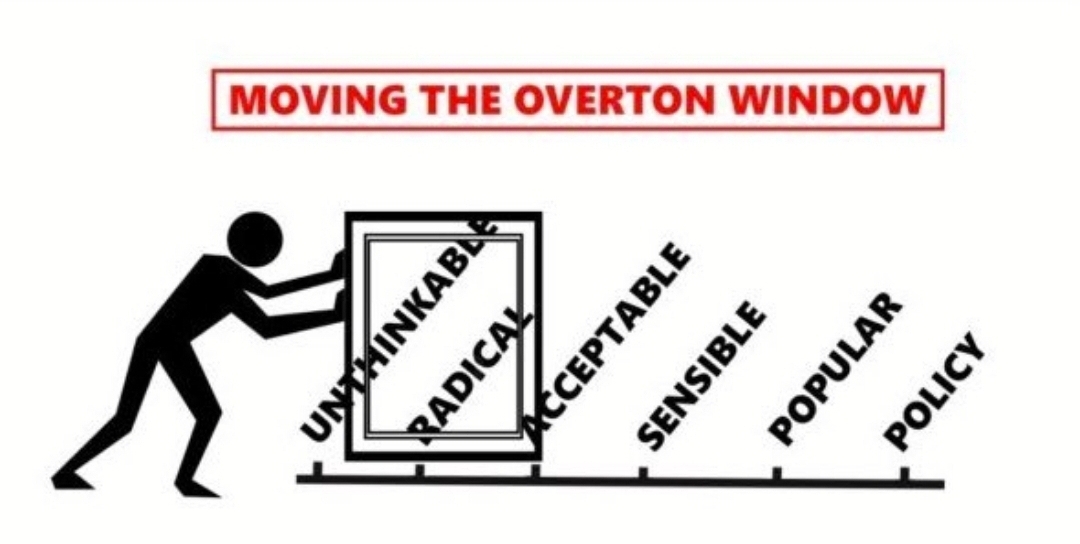
Another question we should ask ourselves. How far have we gotten away from the original (Philadelphia) Constitution?
The Overton Window has allowed the two-party system to slowly and gradually take America out of the sphere and direction of the Philadelphia Constitution onto another path that is more nationalistic than intended.
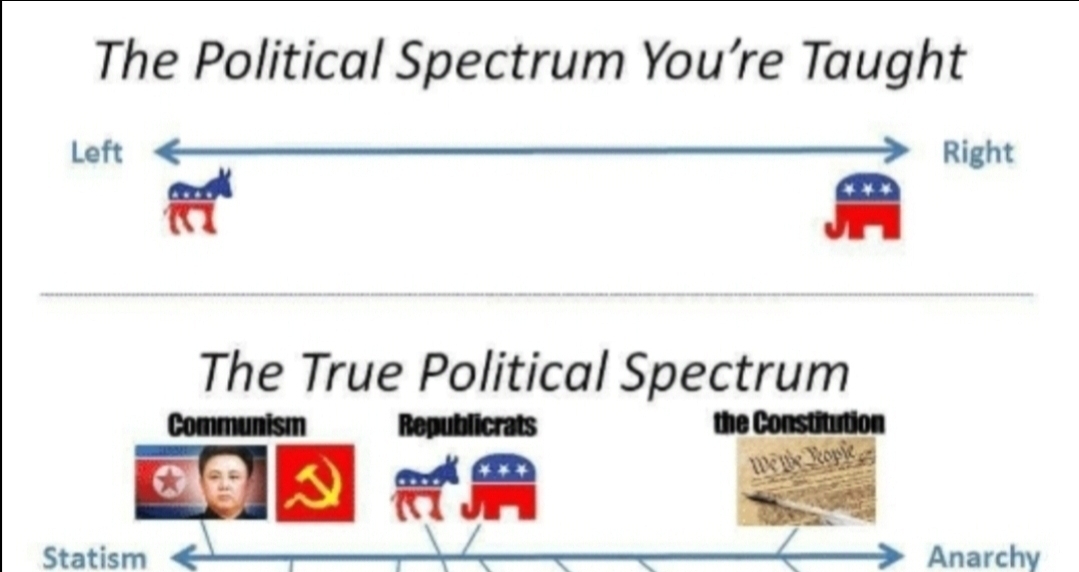
Returning to Alexander Hamilton:
“. . . invented the myth that the Constitution somehow grants the federal government ‘implied powers.’ ‘Implied powers’ are powers that are not actually in the Constitution but that statists like Hamilton wish were.” (9)
Hamilton wrote:
“. . . there are implied, as well as express powers [in the Constitution], and that the former are as effectually delegated as the latter.” (9)
Hamilton merges the two concepts of “expressed powers” and “implied” powers.
Being expressed it being conveyed, denoted, and spelled out. Whereas implied is being creative, imaginative and manipulative.
He not only merged the two concepts, but also managed to manipulate that implied powers were also delegated powers from the states, which in fact this was not the case in the view of Thomas Jefferson and James Madison.
“Implied powers are to be considered as delegated [to the federal government] equally with express ones.” (9)
Hamilton was doing a run around on the Constitution by hinting at powers that weren’t there. Hamilton was considering, desiring and later acting as a great usurper (Here is a current example Is the St. George Utah Mayor, the Great Usurper?). In looking at other words and concepts similar to implied, we can see it is a form of tyranny.
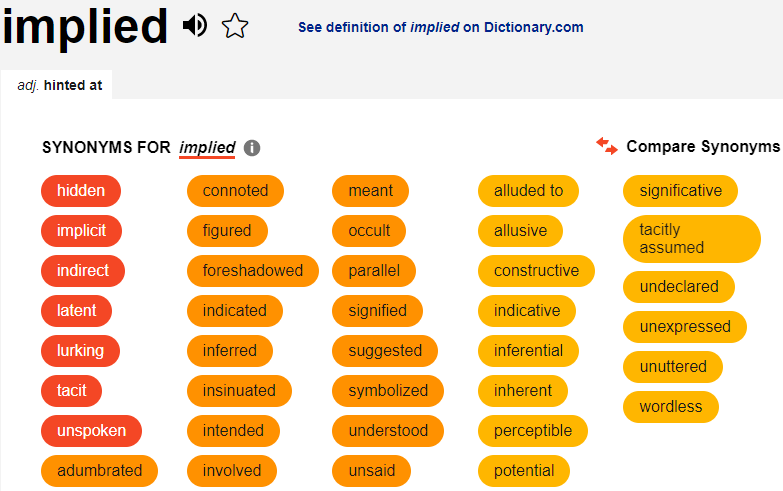
(12)
“Jefferson vehemently disagreed, arguing that the express powers delegated to the federal government in Article 1, Section 8, of the Constitution (providing for the nation defense, coining of money, etc.) were expressly stated because they were the only powers delegated to the federal government by the sovereign states that ratified the Constitution. Any new powers, Jefferson believed, could be delegated only by a constitutional amendment. He realized that such a doctrine as “implied powers” would essentially render the Constitution useless as a tool for limiting government if the limits of government were simply left up to the imaginations of ambitious politicians like Hamilton.” (9)
“Hamilton prevailed, however, and ‘with the aid of the doctrine of implied powers,’ wrote Clinton Rossiter, he ‘converted the . . . powers enumerated in Article 1, Section 8 into firm foundations for whatever prodigious feats of legislation any future Congress might contemplate.'” (9)
“Jefferson’s worst fear was realized . . . the shock troops of the Federalist Party-federally appointed judges-would use Hamilton’s arguments to essentially rewrite history and the Constitution. Thus was ‘liberal judicial activism’ born.” (9)
In George Washington’s farewell address, talks about following the Constitution in the way it “designates” and to not allow any changes happen by way of usurpation. By allowing implied powers, it is allowing the seeds of usurpation to become customary in the culture of society.
“In the way the Constitution designates. But let there be no change by usurpation . . . the customary weapon by which free governments are destroyed.” (9)
(1) The 5000 Year Leap
(2) The Decline of the American Republic and How to Rebuild It by John T. Flynn (1955)
(3) Isaiah 5:13
(4) WTH!? What has the Supreme Court done to State “Rights!?”
(5) Thomas Jefferson Letter to Joseph C. Cabell Letter
(7) Thomas Jefferson
(9) Hamilton’s Curse
(10) Mark Twain
(11) Free Life: The Journal of the Libertarian Alliance Vol. 5 : No.4 – Article 3 of 6
(12) Implied
(13) Loyalists vs Revolutionaries Part 1, Part 2 and Part 3
(14) The battlefield is our culture (Part 1, Part 2, Part 3, and Part 4)

